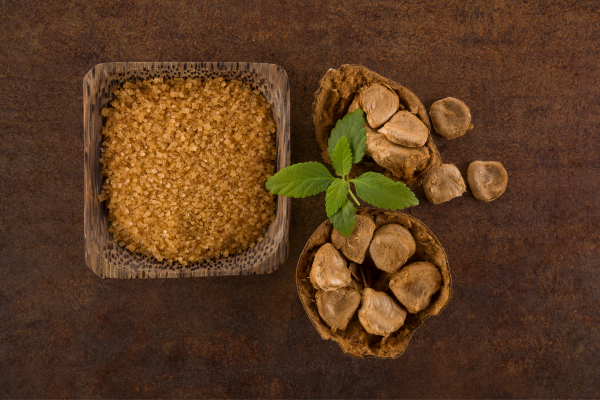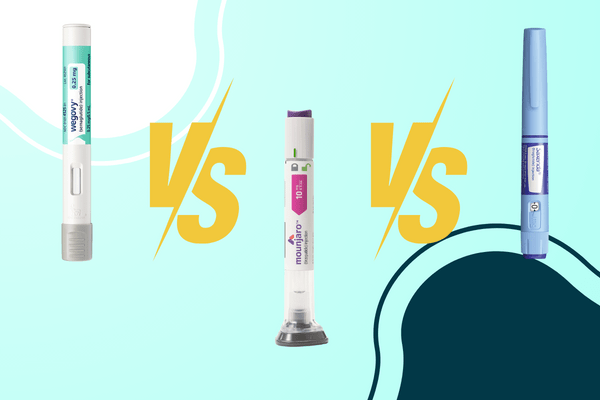Monk fruit, also known as Siraitia grosvenorii Swingle or Luo Han Guo, is becoming increasingly popular as a natural sweetener. The modest monk fruit, native to Southeast Asia, has quietly enchanted palates and traditional medicines for ages. Now, it’s easy sweetness is making its way onto the global stage, providing a tempting alternative to sugar and artificial sweeteners. It is usually considered safe for consumption by the FDA. Let us look further into this amazing ingredient and discover its potential advantages and hidden details.
What is monk fruit?
- A vine from Southeast Asia which is cultivated for its fruit.
- The fruit contains mogrosides, which are between 100-250 times sweeter than sugar.
- Monk fruit extract is created by removing the seeds and peel and purifying the mogrosides.
- Monk fruit’s star power lies in mogrosides, natural compounds that unleash a sweetness 250 times stronger than sugar. But unlike its sugary counterpart, monk fruit avoids the calorie density and blood sugar spikes, making it helpful in weight management and blood sugar control. Imagine indulging in your favorite desserts without the guilt trip – that’s the monk fruit magic!
Where is it found?
- Primarily grown in Southeast Asia, particularly China.
- It is available in various forms: granulated, liquid, powdered blends.
Health benefits
- Gut Health – Early studies suggests it may boost good gut bacteria.
Alternatives and Comparisons
Monk Fruit vs. Stevia vs. Erythritol
| Monk Fruit | Stevia | Erythritol | |
| Taste | Delicate, sugar-like sweetness, no aftertaste. | Intense sweetness, sometimes with a licorice aftertaste. | Subtle sweetness, reminiscent of sugar but less intense. |
| Sweetness Intensity | 100-250 times sweeter than sugar. | 200-300 times sweeter than sugar. | 60-70% sweetness of sugar. |
| Price | Most expensive | Most affordable | Average cost |
| Digestion | Generally well-tolerated. | May cause bloating or laxative effects in some individuals. | Usually it doesn’t cause digestive issues. |
| Health Benefits | No calories or carbs make it a weight-friendly sugar substitute. | May help manage blood sugar. | Zero calories and carbs may be beneficial for weight management. |
| Best For | Those seeking weight loss and familiar sugar-like taste without aftertaste are okay with a higher price. | Budget-conscious individuals who enjoy intense sweetness or are managing blood sugar. | Those prioritising low-calorie/carb intake and digestive comfort. |
Potential risks
- Digestive issues – Mogrosides in monk fruit can act as a laxative, causing bloating, gas, or diarrhea, especially at high doses or for those with sensitive stomachs.
- Hidden sugars – Pre-sweetened monk fruit products often contain added sugars and fillers, outweighing its calorie advantage.
- Research – While generally safe, long-term effects, especially for specific health conditions or pregnant/breastfeeding women, require further exploration. Consult your doctor for personalised advice.
Processing
Monk fruit’s sweetness isn’t magic, but the journey from vine to sweetener is fascinating. Here’s the condensed version:
- Cultivation – Grown in Southeast Asia with care and expertise.
- Harvest – Hand-picked at peak sweetness to preserve delicate mogrosides (sweet compounds).
- Dried – Traditional methods (sun) or modern techniques (freeze-drying) removes moisture and concentrates sweetness.
- Extraction – Water or food-grade solvents isolate the sweet essence.
- Purification – Advanced techniques further concentrate sweetness and ensure purity.
- Final Touches – Depending on the desired form (granulated, liquid, etc.), the extract undergoes specific transformations.
- Quality Control – Rigorous testing ensures a safe, consistent product.
Functional Food Champion
Think beyond calorie-cutting. Monk fruit isn’t just shedding unwanted pounds, it is packing a punch of potential health benefits. Studies suggest it might offer antioxidant power, fighting free radicals and potentially reducing inflammation. And whispers of gut health improvement are enticing, suggesting monk fruit could promote beneficial bacteria, boosting overall well-being.
Food processing powerhouse
Monk fruit’s versatility shines in food processing. Its neutral taste adapts readily to various applications, from baked goods and beverages to sauces and marinades. This makes it a game-changer for manufacturers seeking to cater to health-conscious consumers without compromising taste or functionality.
Beyond the Hype
As with any innovation, challenges exist. Cost remains a hurdle, and monk fruit’s unique taste profile might not win over every palate. However, research and development are addressing these concerns. Blending with other sweeteners can create a more universal taste, while improved extraction processes aim to make it more budget-friendly.
Looking Ahead
The future of monk fruit in food processing seems bright. Its natural origin, lack of aftertaste, and potential health benefits position it as a strong contender in the sweetener arena. Continued innovation, affordability improvement, and a robust scientific backing will pave the way for its reign supreme.
Additional notes
Monk fruit sweetener can be used in baking and cooking like regular sugar.
- Due to its intense sweetness, you might need less than sugar in recipes.
- Consider taste preferences and potential side effects when choosing it.
Ultimately, monk fruit seems like a promising natural sweetener with potential health benefits However, before making any dietary changes, consult with your physician for advice.
- Antioxidant – Its antioxidants may combat free radicals and may relieve inflammation.
- Gut Health – Early studies suggests it may boost good gut bacteria.
Alternatives and Comparisons
Monk Fruit vs. Stevia vs. Erythritol
| Monk Fruit | Stevia | Erythritol | |
| Taste | Delicate, sugar-like sweetness, no aftertaste. | Intense sweetness, sometimes with a licorice aftertaste. | Subtle sweetness, reminiscent of sugar but less intense. |
| Sweetness Intensity | 100-250 times sweeter than sugar. | 200-300 times sweeter than sugar. | 60-70% sweetness of sugar. |
| Price | Most expensive | Most affordable | Average cost |
| Digestion | Generally well-tolerated. | May cause bloating or laxative effects in some individuals. | Usually it doesn’t cause digestive issues. |
| Health Benefits | No calories or carbs make it a weight-friendly sugar substitute. | May help manage blood sugar. | Zero calories and carbs may be beneficial for weight management. |
| Best For | Those seeking weight loss and familiar sugar-like taste without aftertaste are okay with a higher price. | Budget-conscious individuals who enjoy intense sweetness or are managing blood sugar. | Those prioritising low-calorie/carb intake and digestive comfort. |
Potential risks
- Digestive issues – Mogrosides in monk fruit can act as a laxative, causing bloating, gas, or diarrhea, especially at high doses or for those with sensitive stomachs.
- Hidden sugars – Pre-sweetened monk fruit products often contain added sugars and fillers, outweighing its calorie advantage.
- Research – While generally safe, long-term effects, especially for specific health conditions or pregnant/breastfeeding women, require further exploration. Consult your doctor for personalised advice.
Processing
Monk fruit’s sweetness isn’t magic, but the journey from vine to sweetener is fascinating. Here’s the condensed version:
- Cultivation – Grown in Southeast Asia with care and expertise.
- Harvest – Hand-picked at peak sweetness to preserve delicate mogrosides (sweet compounds).
- Dried – Traditional methods (sun) or modern techniques (freeze-drying) removes moisture and concentrates sweetness.
- Extraction – Water or food-grade solvents isolate the sweet essence.
- Purification – Advanced techniques further concentrate sweetness and ensure purity.
- Final Touches – Depending on the desired form (granulated, liquid, etc.), the extract undergoes specific transformations.
- Quality Control – Rigorous testing ensures a safe, consistent product.
Functional Food Champion
Think beyond calorie-cutting. Monk fruit isn’t just shedding unwanted pounds, it is packing a punch of potential health benefits. Studies suggest it might offer antioxidant power, fighting free radicals and potentially reducing inflammation. And whispers of gut health improvement are enticing, suggesting monk fruit could promote beneficial bacteria, boosting overall well-being.
Food processing powerhouse
Monk fruit’s versatility shines in food processing. Its neutral taste adapts readily to various applications, from baked goods and beverages to sauces and marinades. This makes it a game-changer for manufacturers seeking to cater to health-conscious consumers without compromising taste or functionality.
Beyond the Hype
As with any innovation, challenges exist. Cost remains a hurdle, and monk fruit’s unique taste profile might not win over every palate. However, research and development are addressing these concerns. Blending with other sweeteners can create a more universal taste, while improved extraction processes aim to make it more budget-friendly.
Looking Ahead
The future of monk fruit in food processing seems bright. Its natural origin, lack of aftertaste, and potential health benefits position it as a strong contender in the sweetener arena. Continued innovation, affordability improvement, and a robust scientific backing will pave the way for its reign supreme.
Additional notes
Monk fruit sweetener can be used in baking and cooking like regular sugar.
- Due to its intense sweetness, you might need less than sugar in recipes.
- Consider taste preferences and potential side effects when choosing it.
Ultimately, monk fruit seems like a promising natural sweetener with potential health benefits However, before making any dietary changes, consult with your physician for advice.





